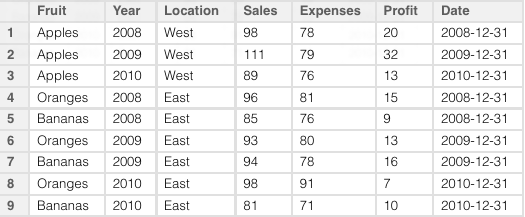R reminds me a lot of English. It’s easy to get started, but very difficult to master. So for all those times I’ve spent… well, forever… trying to figure out the “R way” of doing something, I’m glad to share these quick wins.
My recent R tutorial on mining Twitter for consumer sentiment wouldn’t have been possible without Jeff Gentry’s amazing twitteR package (available on CRAN). It does so much of the behind-the-scenes heavy lifting to access Twitter’s REST APIs, that one line of code is all you need to perform a search and retrieve the (even paginated) results:
library(twitteR)
tweets = searchTwitter("#rstats", n=1500)
You can search for anything, of course, “#rstats” is just an example. (And if you’re really into that hashtag, the twitteR package even provides an Rtweets() function which hardcodes that search string for you.) The n=1500 specifies the maximum number of tweets supported by the Search API, though you may retrieve fewer as Twitter’s search indices contain only a couple of days’ tweets.
What you get back is a list of tweets (technically “status updates”):
> head(tweets) [[1]] [1] "Cloudnumberscom: CloudNumbers.com \023 #Rstats gets real in the cloud http://t.co/Vw4Gupr via @AddToAny" [[2]] [1] "0_h_r_1: CloudNumbers.com \023 #Rstats gets real in the cloud via DecisionStats - I came across Cloudnumbers.com . ... http://tinyurl.com/5sjagjg" [[3]] [1] "cmprsk: RT I just joined the beta to run #Rstats in the cloud with cloudnumbers.com http://t.co/lvVp0YJ via @cloudnumberscom http://bit.ly/lbSruR" [[4]] [1] "0_h_r_1: I just joined the beta to run #Rstats in the cloud with cloudnumbers.com http://t.co/lvVp0YJ via @cloudnumberscom" [[5]] [1] "cmprsk: RT man, the #rstats think people I am too soft on #sas, the #sas people think I am too soft on #wps, the #wps pe... http://bit.ly/innEv8" [[6]] [1] "keepstherainoff: Thanks to @cmprsk @geoffjentry and @MikeKSmith for colour-coded #Rstats GUI advice" > class(tweets[[1]]) [1] "status" attr(,"package") [1] "twitteR"
Now that you have some tweets, the fun really begins. To get you started, the status class includes a very handy toDataFrame() accessor method (see ?status):
> library(plyr) > tweets.df = ldply(tweets, function(t) t$toDataFrame() )

> str(tweets.df) 'data.frame': 131 obs. of 10 variables: $ text : Factor w/ 122 levels "CloudNumbers.com \023 #Rstats gets real in the cloud http://t.co/Vw4Gupr via @AddToAny",..: 1 2 3 4 5 6 7 8 9 10 ... $ favorited : logi NA NA NA NA NA NA ... $ replyToSN : logi NA NA NA NA NA NA ... $ created : POSIXct, format: "2011-07-04 13:50:39" "2011-07-04 13:48:10" "2011-07-04 13:29:00" "2011-07-04 13:23:42" ... $ truncated : logi FALSE FALSE FALSE FALSE FALSE FALSE ... $ replyToSID : logi NA NA NA NA NA NA ... $ id : Factor w/ 131 levels "87941406873751552",..: 1 2 3 4 5 6 7 8 9 10 ... $ replyToUID : logi NA NA NA NA NA NA ... $ statusSource: Factor w/ 17 levels "<a href="http://twitter.com/tweetbutton" rel="nofollow">Tweet Button</a>",..: 1 2 3 1 3 4 5 5 3 4 ... $ screenName : Factor w/ 64 levels "Cloudnumberscom",..: 1 2 3 2 3 4 2 5 3 6 ...
You can pull a particular user’s tweets just as easily with the userTimeline() function. Heck, the package even lets you tweet from R if you use Jeff’s companion ROAuth package, but that requires more than one line….
Enjoy!

